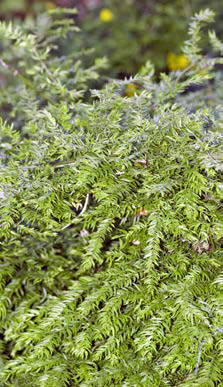Trip Report – 18 May 2013: Te Marua Bush workbee
 |
Asparagus scandens has the potential to become a serious problem in the reserve where it could smother seedlings and understorey plants.
Photo: Jeremy Rolfe.
|
Despite the long summer drought, the bush looked surprisingly healthy, with plenty of new growth. This was helped by the almost complete lack of cicadas emerging, so the severe damage seen most years was absent. Black maire had grown long new shoots low down and on the crowns. The plantings alongside the Pony Club paddock had thickened up to form a good windbreak for the bush. Convolvulus continues to invade the strip.
In the southern planted area, we planted eleven trees in gaps, and pruned some earlier plantings to create light wells where podocarps have been planted. We searched for weeds, and saw that recent weed control organised by Greater Wellington had been effective. We found two new weed species – climbing asparagus
Asparagus scandens, and coastal banksia
Banksia integrifolia. The latter had presumably arrived by wind or bird from large specimens across the road.
We thank Nathan Wickens, GWRC ranger, for removing the bags of weeds and rubbish that we had collected.
Participants : Chris Horne, Rodney Lewington, Sue Millar (co-leader / scribe), Grant Roberts, Allan Sheppard, Glennis Sheppard (co-leader), Darea Sherratt.
Trip Report – 16 November 2013: Te Marua Bush workbee
Our group of ten BotSoc and Forest & Bird members spent a worthwhile session releasing plants from weeds, and having a good look through the area.
After a mild winter, the plantings have grown considerably. This was especially noticeable at the south end of the planting, where plants have now grown together to form a dense windbreak. This cold, windy corner was planted in 2007, and it has been hard to get plants established to give protection for the rest of the planting here.
The adjacent, older planting (1999-2007) has now reached the stage of needing some heavy pruning of the hebes and other faster-growing species, in order to make sure the longer-living, but slower-growing, trees have enough light and space to grow up through. There are plenty of young seedlings here which will be able to fill in any future gaps.
About sixteen
Hoheria populnea trees were removed as these were not the correct species for the area. Despite being fast-growing, their overall survival rate was poor as ninety-five had been planted throughout the area.
The 2008-2012 plantings along the edge of the Pony Club paddock to the north have grown well and form an attractive windbreak. Convolvulus is a problem in two areas. The bush edge along SH2 was cut into to re-align the road a few years ago, and although it was re-fenced, it is still a collecting area for dumped and wind-blown rubbish of all sorts, as well as undesirable assorted exotic grasses and other weeds.
Participants : Roz Brown, Trudi Bruhlmann, Barbara Clark, Chris Horne, Sue Millar (co-leader / scribe), Barbara Mitcalfe, Allan, Glennis, (co-leader), and Graeme Sheppard, Sunita Singh.

 Site Index
Site Index







 Site Index
Site Index





